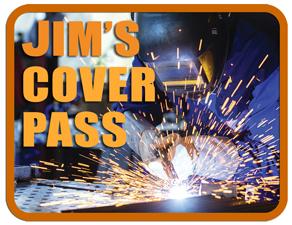Senior Company Trainer
- FMA
- The Fabricator
- FABTECH
- Canadian Metalworking
Categories
- Additive Manufacturing
- Aluminum Welding
- Arc Welding
- Assembly and Joining
- Automation and Robotics
- Bending and Forming
- Consumables
- Cutting and Weld Prep
- Electric Vehicles
- En Español
- Finishing
- Hydroforming
- Laser Cutting
- Laser Welding
- Machining
- Manufacturing Software
- Materials Handling
- Metals/Materials
- Oxyfuel Cutting
- Plasma Cutting
- Power Tools
- Punching and Other Holemaking
- Roll Forming
- Safety
- Sawing
- Shearing
- Shop Management
- Testing and Measuring
- Tube and Pipe Fabrication
- Tube and Pipe Production
- Waterjet Cutting
Industry Directory
Webcasts
Podcasts
FAB 40
Advertise
Subscribe
Account Login
Search
Jim's Cover Pass: Don’t know what to teach nonwelders about welding? Here’s a start
- By Jim Mosman, AWS, CWI/CWE
- August 3, 2022
- Article
- Arc Welding
Q: I am a welding training and development specialist, and I have been asked to teach welding to our maintenance personnel. What do you recommend for course content when teaching SMAW and GMAW processes?
The first thing that should be covered is welding safety. This should begin with using the proper PPE—selecting the correct welding lens shade based on the process and the amperage being used; wearing quality welding gloves and a welding jacket to provide protection from the heat, sparks, and arc; and wearing heavy jeans or work pants without any fraying.
Next is equipment safety. Check all cables for cuts, burns, and proper connections. Check the welding power source, electrode holder, or GMAW gun; check the work clamp for the rated amperage and proper connections.
Last on the safety training agenda should be the welding environment. Help them understand that welding and cutting sparks can travel up to 35 ft., and that all flammable objects should be removed or covered in that welding zone. Perhaps a hot-work permit is required in the facility, along with a fire watch during and after welding.
The next topic that should be covered is general welding principles. They’ll need a basic understanding of electrical current and the difference between constant-current and constant-voltage power sources. They’ll need to know that SMAW uses constant current and GMAW uses constant voltage.
Include lessons on when to use direct current electrode positive (DCEP) and direct current electrode negative (DCEN)— that SMAW will usually use DCEP but sometimes DCEN or AC, and that GMAW will always use DCEP. Welding principles also should include proper electrode selection and an understanding of the AWS electrode numbering system.
Provide recommendations on which process should be chosen for various circumstances within the facility. The welding process that should be covered and practiced first may depend on which process is used predominately for maintenance at your facility. It really does not matter which you choose.
Spend time on the basic theories of each welding process. Include instructor demonstrations and directions along with several hours of hands-on practice in both a welding booth and on potential maintenance projects.
You did not mention training with the oxyfuel processes. For maintenance personnel, this topic should also be included. Again, safety principles, cylinder and torch equipment setup and selection, startup and shutdown procedures, and cutting practice are essential to become familiar with the process.
Finally, it is helpful to have the new crew members shadow those with experience for a period of time after the formal training is complete.
About the Author

Jim Mosman, AWS, CWI/CWE
Lincoln Electric Education Division
About the Publication
subscribe now

The Welder, formerly known as Practical Welding Today, is a showcase of the real people who make the products we use and work with every day. This magazine has served the welding community in North America well for more than 20 years.
start your free subscription- Stay connected from anywhere

Easily access valuable industry resources now with full access to the digital edition of The Fabricator.

Easily access valuable industry resources now with full access to the digital edition of The Welder.

Easily access valuable industry resources now with full access to the digital edition of The Tube and Pipe Journal.
- Podcasting
- Podcast:
- The Fabricator Podcast
- Published:
- 04/16/2024
- Running Time:
- 63:29
In this episode of The Fabricator Podcast, Caleb Chamberlain, co-founder and CEO of OSH Cut, discusses his company’s...
- Industry Events
16th Annual Safety Conference
- April 30 - May 1, 2024
- Elgin,
Pipe and Tube Conference
- May 21 - 22, 2024
- Omaha, NE
World-Class Roll Forming Workshop
- June 5 - 6, 2024
- Louisville, KY
Advanced Laser Application Workshop
- June 25 - 27, 2024
- Novi, MI

































